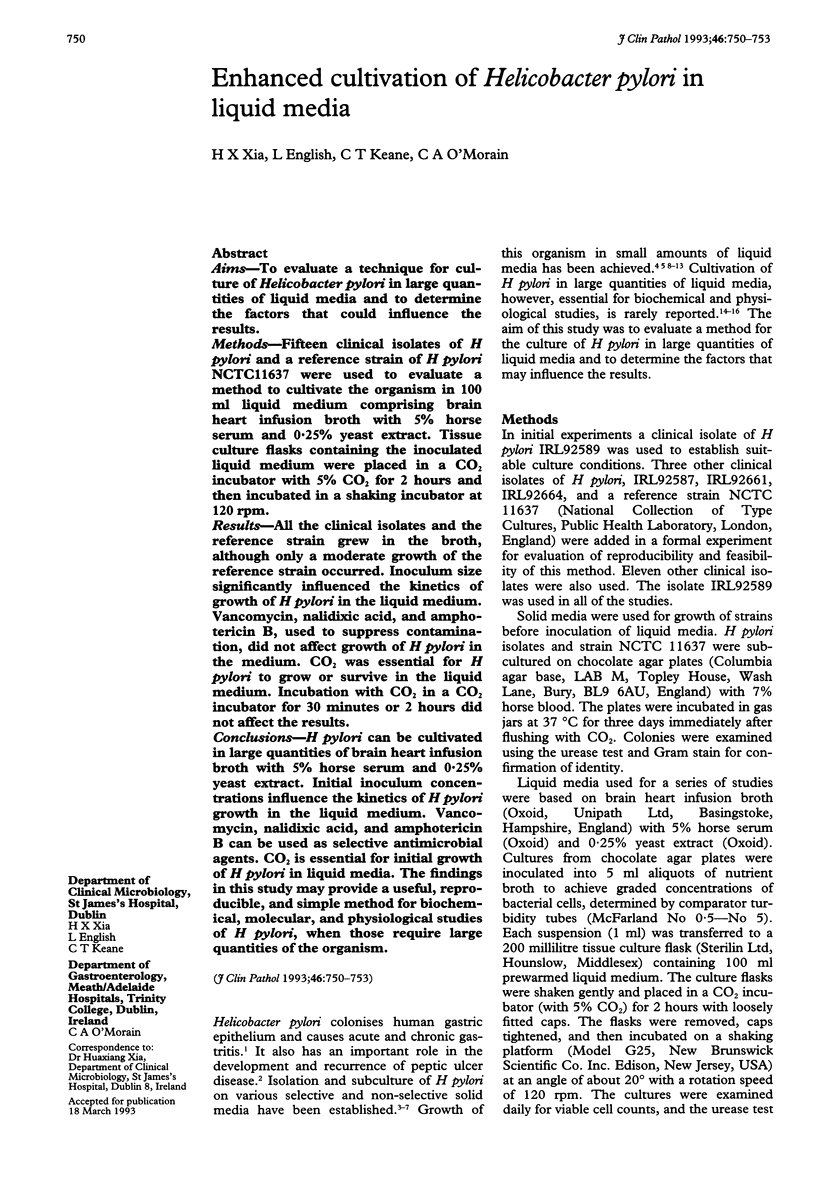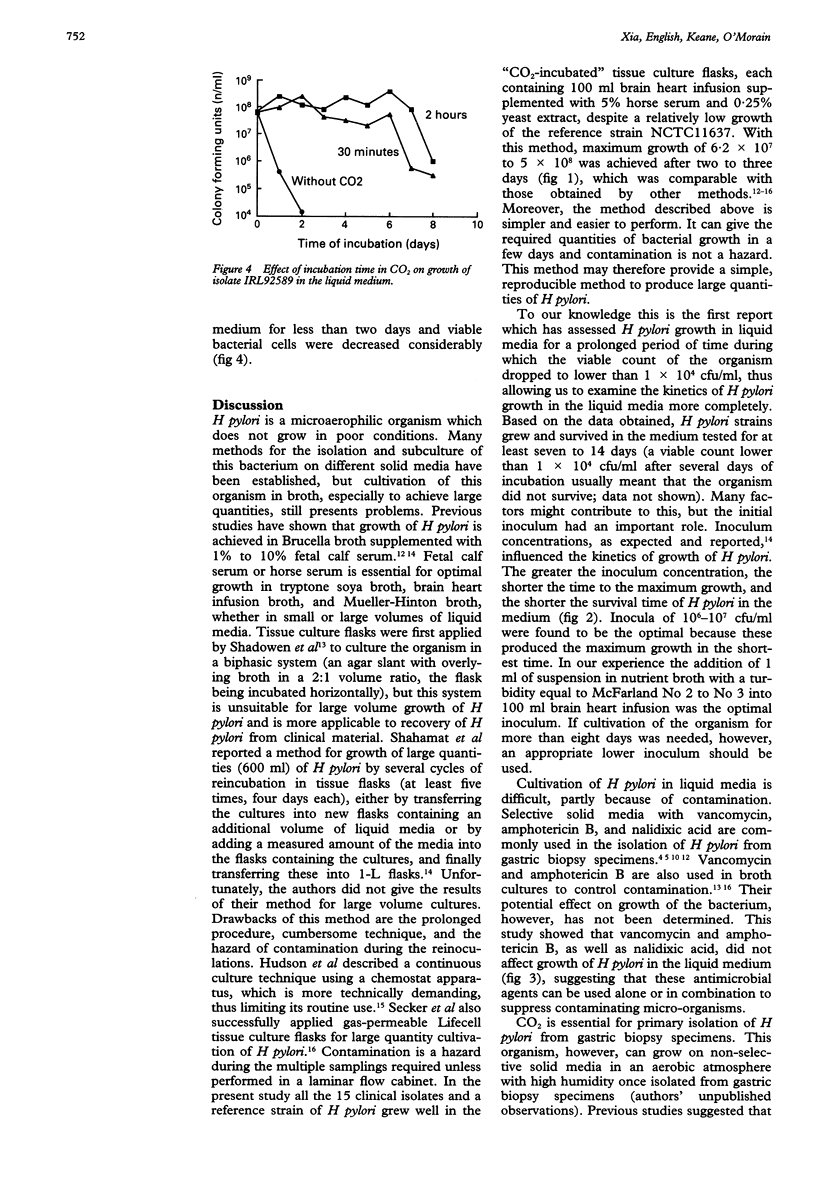Abstract
AIMS--To evaluate a technique for culture of Helicobacter pylori in large quantities of liquid media and to determine the factors that could influence the results. METHODS--Fifteen clinical isolates of H pylori and a reference strain of H pylori NCTC11637 were used to evaluate a method to cultivate the organism in 100 ml liquid medium comprising brain heart infusion broth with 5% horse serum and 0.25% yeast extract. Tissue culture flasks containing the inoculated liquid medium were placed in a CO2 incubator with 5% CO2 for 2 hours and then incubated in a shaking incubator at 120 rpm. RESULTS--All the clinical isolates and the reference strain grew in the broth, although only a moderate growth of the reference strain occurred. Inoculum size significantly influenced the kinetics of growth of H pylori in the liquid medium. Vancomycin, nalidixic acid, and amphotericin B, used to suppress contamination, did not affect growth of H pylori in the medium. CO2 was essential for H pylori to grow or survive in the liquid medium. Incubation with CO2 in a CO2 incubator for 30 minutes or 2 hours did not affect the results. CONCLUSIONS--H pylori can be cultivated in large quantities of brain heart infusion broth with 5% horse serum and 0.25% yeast extract. Initial inoculum concentrations influence the kinetics of H pylori growth in the liquid medium. Vancomycin, nalidixic acid, and amphotericin B can be used as selective antimicrobial agents. CO2 is essential for initial growth of H pylori in liquid media. The findings in this study may provide a useful, reproducible, and simple method for biochemical, molecular, and physiological studies of H pylori, when those require large quantities of the organism.
Full text
PDF



Selected References
These references are in PubMed. This may not be the complete list of references from this article.
- Ansorg R., Von Recklinghausen G., Pomarius R., Schmid E. N. Evaluation of techniques for isolation, subcultivation, and preservation of Helicobacter pylori. J Clin Microbiol. 1991 Jan;29(1):51–53. doi: 10.1128/jcm.29.1.51-53.1991. [DOI] [PMC free article] [PubMed] [Google Scholar]
- Buck G. E., Smith J. S. Medium supplementation for growth of Campylobacter pyloridis. J Clin Microbiol. 1987 Apr;25(4):597–599. doi: 10.1128/jcm.25.4.597-599.1987. [DOI] [PMC free article] [PubMed] [Google Scholar]
- Dent J. C., McNulty C. A. Evaluation of a new selective medium for Campylobacter pylori. Eur J Clin Microbiol Infect Dis. 1988 Aug;7(4):555–558. doi: 10.1007/BF01962615. [DOI] [PubMed] [Google Scholar]
- Goodwin C. S., Blake P., Blincow E. The minimum inhibitory and bactericidal concentrations of antibiotics and anti-ulcer agents against Campylobacter pyloridis. J Antimicrob Chemother. 1986 Mar;17(3):309–314. doi: 10.1093/jac/17.3.309. [DOI] [PubMed] [Google Scholar]
- Goodwin C. S., Blincow E. D., Warren J. R., Waters T. E., Sanderson C. R., Easton L. Evaluation of cultural techniques for isolating Campylobacter pyloridis from endoscopic biopsies of gastric mucosa. J Clin Pathol. 1985 Oct;38(10):1127–1131. doi: 10.1136/jcp.38.10.1127. [DOI] [PMC free article] [PubMed] [Google Scholar]
- Hazell S. L., Markesich D. C., Evans D. J., Evans D. G., Graham D. Y. Influence of media supplements on growth and survival of Campylobacter pylori. Eur J Clin Microbiol Infect Dis. 1989 Jul;8(7):597–602. doi: 10.1007/BF01968136. [DOI] [PubMed] [Google Scholar]
- Krajden S., Bohnen J., Anderson J., Kempston J., Fuksa M., Matlow A., Marcon N., Haber G., Kortan P., Karmali M. Comparison of selective and nonselective media for recovery of Campylobacter pylori from antral biopsies. J Clin Microbiol. 1987 Jun;25(6):1117–1118. doi: 10.1128/jcm.25.6.1117-1118.1987. [DOI] [PMC free article] [PubMed] [Google Scholar]
- Leunk R. D., Johnson P. T., David B. C., Kraft W. G., Morgan D. R. Cytotoxic activity in broth-culture filtrates of Campylobacter pylori. J Med Microbiol. 1988 Jun;26(2):93–99. doi: 10.1099/00222615-26-2-93. [DOI] [PubMed] [Google Scholar]
- Mathai E., Cafferkey M., Keane C., O'Morain C. Evaluation of different solid media used for cultivation of Helicobacter (Campylobacter) pylori. Indian J Med Res. 1992 Jan;95:23–25. [PubMed] [Google Scholar]
- Morgan D. R., Freedman R., Depew C. E., Kraft W. G. Growth of Campylobacter pylori in liquid media. J Clin Microbiol. 1987 Nov;25(11):2123–2125. doi: 10.1128/jcm.25.11.2123-2125.1987. [DOI] [PMC free article] [PubMed] [Google Scholar]
- Patchett S., Beattie S., Leen E., Keane C., O'Morain C. Helicobacter pylori and duodenal ulcer recurrence. Am J Gastroenterol. 1992 Jan;87(1):24–27. [PubMed] [Google Scholar]
- Secker D. A., Tompkins D. S., Alderson G. Gas-permeable lifecell tissue culture flasks give improved growth of Helicobacter pylori in a liquid medium. J Clin Microbiol. 1991 May;29(5):1060–1061. doi: 10.1128/jcm.29.5.1060-1061.1991. [DOI] [PMC free article] [PubMed] [Google Scholar]
- Shadowen R. D., Sciortino C. V. Improved growth of Campylobacter pylori in a biphasic system. J Clin Microbiol. 1989 Aug;27(8):1744–1747. doi: 10.1128/jcm.27.8.1744-1747.1989. [DOI] [PMC free article] [PubMed] [Google Scholar]
- Shahamat M., Mai U. E., Paszko-Kolva C., Yamamoto H., Colwell R. R. Evaluation of liquid media for growth of Helicobacter pylori. J Clin Microbiol. 1991 Dec;29(12):2835–2837. doi: 10.1128/jcm.29.12.2835-2837.1991. [DOI] [PMC free article] [PubMed] [Google Scholar]
- Unidentified curved bacilli on gastric epithelium in active chronic gastritis. Lancet. 1983 Jun 4;1(8336):1273–1275. [PubMed] [Google Scholar]


